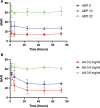Assessment of the Haemostatic Potential of Platelets Readied for Transfusion
- PMID: 40109577
- PMCID: PMC11922168
- DOI: 10.1055/a-2525-6768
Assessment of the Haemostatic Potential of Platelets Readied for Transfusion
Conflict of interest statement
Conflict of Interest None declared.
Figures



Similar articles
-
Observational study of haemostatic dysfunction and bleeding in neonates with hypoxic-ischaemic encephalopathy.BMJ Open. 2017 Feb 9;7(2):e013787. doi: 10.1136/bmjopen-2016-013787. BMJ Open. 2017. PMID: 28183808 Free PMC article.
-
A comparison of haemostatic biomarkers during low-risk patients undergoing cardiopulmonary bypass using either conventional centrifugal cell salvage or the HemoSep device.Perfusion. 2019 Jan;34(1):76-83. doi: 10.1177/0267659118789051. Epub 2018 Aug 1. Perfusion. 2019. PMID: 30067140 Clinical Trial.
-
The haemostatic effect of 51CR-labelled blood platelets. An experimental study in the rabbit.Scand J Haematol. 1977 Apr;18(4):326-32. doi: 10.1111/j.1600-0609.1977.tb01203.x. Scand J Haematol. 1977. PMID: 857294
-
Peripartum Haemorrhage: Haemostatic Aspects of the Updated Peripartum Haemorrhage Guideline of the German-Speaking Countries.Transfus Med Hemother. 2023 Jun 6;50(6):547-558. doi: 10.1159/000530659. eCollection 2023 Dec. Transfus Med Hemother. 2023. PMID: 38089489 Free PMC article. Review.
-
Management of major blood loss: an update.Acta Anaesthesiol Scand. 2010 Oct;54(9):1039-49. doi: 10.1111/j.1399-6576.2010.02265.x. Epub 2010 Jul 6. Acta Anaesthesiol Scand. 2010. PMID: 20626354 Review.
References
-
- Banerjee S, Angiolillo D J, Boden W E et al.Use of antiplatelet therapy/DAPT for post-PCI patients undergoing noncardiac surgery. J Am Coll Cardiol. 2017;69(14):1861–1870. - PubMed
-
- Taylor G, Osinski D, Thevenin A, Devys J-M. Is platelet transfusion efficient to restore platelet reactivity in patients who are responders to aspirin and/or clopidogrel before emergency surgery? J Trauma Acute Care Surg. 2013;74(05):1367–1369. - PubMed
-
- Nagalla S, Sarode R. Role of platelet transfusion in the reversal of anti-platelet therapy. Transfus Med Rev. 2019;33(02):92–97. - PubMed
LinkOut - more resources
Full Text Sources

